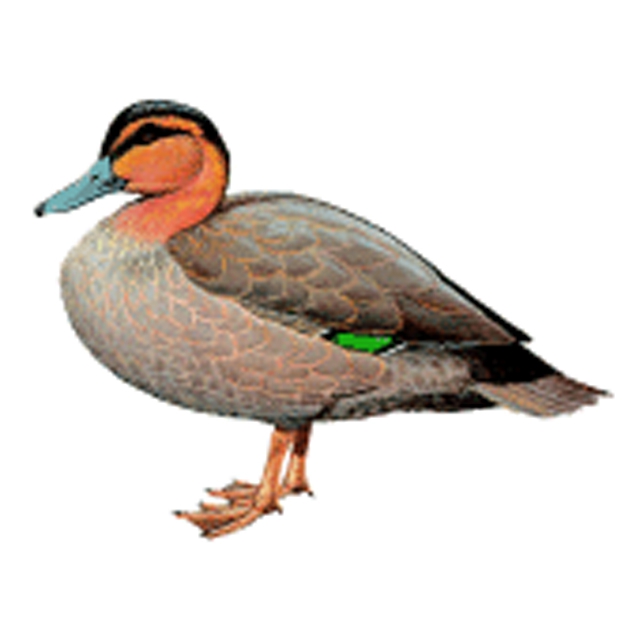| Citation |
v |
Description |
JUSTIFICATION
This duck is listed as Vulnerable because it is undergoing a rapid and continuing decline owing to extensive over-hunting and the widespread conversion of its wetland habitats.
RANGE DESCRIPTION
Anas luzonica is endemic to the Philippines, being recorded from all the major islands and eight smaller islands. Records are mostly from Luzon and Mindanao. Records from Siquijor and the Sulus remain unsubstantiated. A steep population decline was evident by the mid-1970s, with high numbers recorded at only a few sites in the following decade, e.g. Candaba Marsh (Luzon) which probably supported many thousands in the early 1980s, though in 2012 only 390 individuals were recorded. Important current areas include Malasi Lake (7000 individuals in 2013), Brgy. Perlas (3252 in 2013, San Roque Multi-purpose Project (3500 individuals in 2013), Biong & Pandan. Cabusao Wetland Area (3000 individuals in 2011, though only 2 in 2013), Subic Bay (600 seen in 1997, 400 in 2003), Magat dam (2,000 were seen in 2001, 495 in 2013) and Malasi lakes (1,320 were recorded in 2002 and 7,000 in 2013). Other recent records come from Mangatarem, Pangasinan (east of Zambales Mountains IBA) where 70 individuals were counted on the Barabac River inside the Manleluag Spring National Park, Cantilan mangroves in Surigao del Sur and from a mangrove fishpond in Bicol Region, Southern Luzon (B. Tabaranza in litt. 2007). In 1993, its population was estimated at 10,000-100,000, but by 2002 fewer than 10,000 birds were thought to remain.
DESCRIPTION
A total of 4,632 individuals were counted in the Asian Waterbird Census in 2004, and 4,428 in 2005 (D. Li in litt. 2005). The total population is likely to fall between 5,000-10,000 individuals, roughly equating to 3,300-6,700 mature individuals.
Trend Justification: A steep population decline was evident by the mid-1970s, with high numbers recorded at only a few sites in the following decade. Subsequent local extinctions and near-disappearances have occurred in several significant sites, owing to exceptionally high levels of hunting and trapping, conversion of natural wetlands, mangrove destruction and the recent extensive use of pesticides on rice-fields. This speciess population is suspected to be undergoing a rapid and continuing decline in line with these impacts.
HABITAT AND ECOLOGY
It frequents most freshwater and saltwater habitats, including mangroves, open sea and watercourses inside forest. It appears to be sedentary although some seasonal aggregation occurs. It feeds on fish, shrimps, insects, rice and young vegetation.
THREATS
Exceptionally high levels of hunting and trapping have been evident since the 1960s. Thousands were reportedly shot weekly in August-October and January-March in the late 1980s. Conversion of natural wetlands through drainage, adoption of aquaculture and fishpond creation threatened the species at Candaba Marsh and Polillo. The on-going conversion of habitat at Liguasan is also thought to be impacting the species (D. Allen in litt. 2012). Mangrove destruction and the recent extensive use of pesticides on rice-fields are also likely to have had serious impacts.
CONSERVATION ACTIONS
Conservation Actions Underway
It is legally protected at five localities: Mt Iglit-Baco and Lake Naujan National Parks (Mindoro), Maria Aurora Memorial Natural Park and Bataan Natural Park/Subic Bay Forest Reserve (Luzon), and Olango Island (a Ramsar site). The Mayor of Candaba has designated part of Candaba Marsh as a protected area and two local conservation groups have been established as well as promotional materials: signs and a video documentary (B. Tabaranza in litt. 2007). The Manleluag Spring National Park, Mangatarem, Pangasinan has been a Protected Landscape since 1940 under Proclamation No. 612. At present, with the assistance of Haribon, the Local government of Mangatarem and the Protected Area Management Board of the park are proposing to expand the area of the park from 1,935 hectares to 4,240 hectares to include all the remaining tropical rainforests extending up to the boundary with Zambales Province. A government ban on firearms was imposed in 1972, although hunting continues.
Conservation Actions Proposed
Gain a better understanding of the global population status. Survey remaining wetland areas, especially around Polillo and Subic Bay. Conduct long-term ecological studies to establish management requirements. Afford protected status to key sites (e.g. Polillo) and ensure hunting restrictions are enforced. Recreate natural marsh habitat at Candaba. Develop a management plan for the remaining wetland habitat at key sites including Lake Naujan. Conduct thorough threat assessment to identify other possible threats such as egg collection. |


